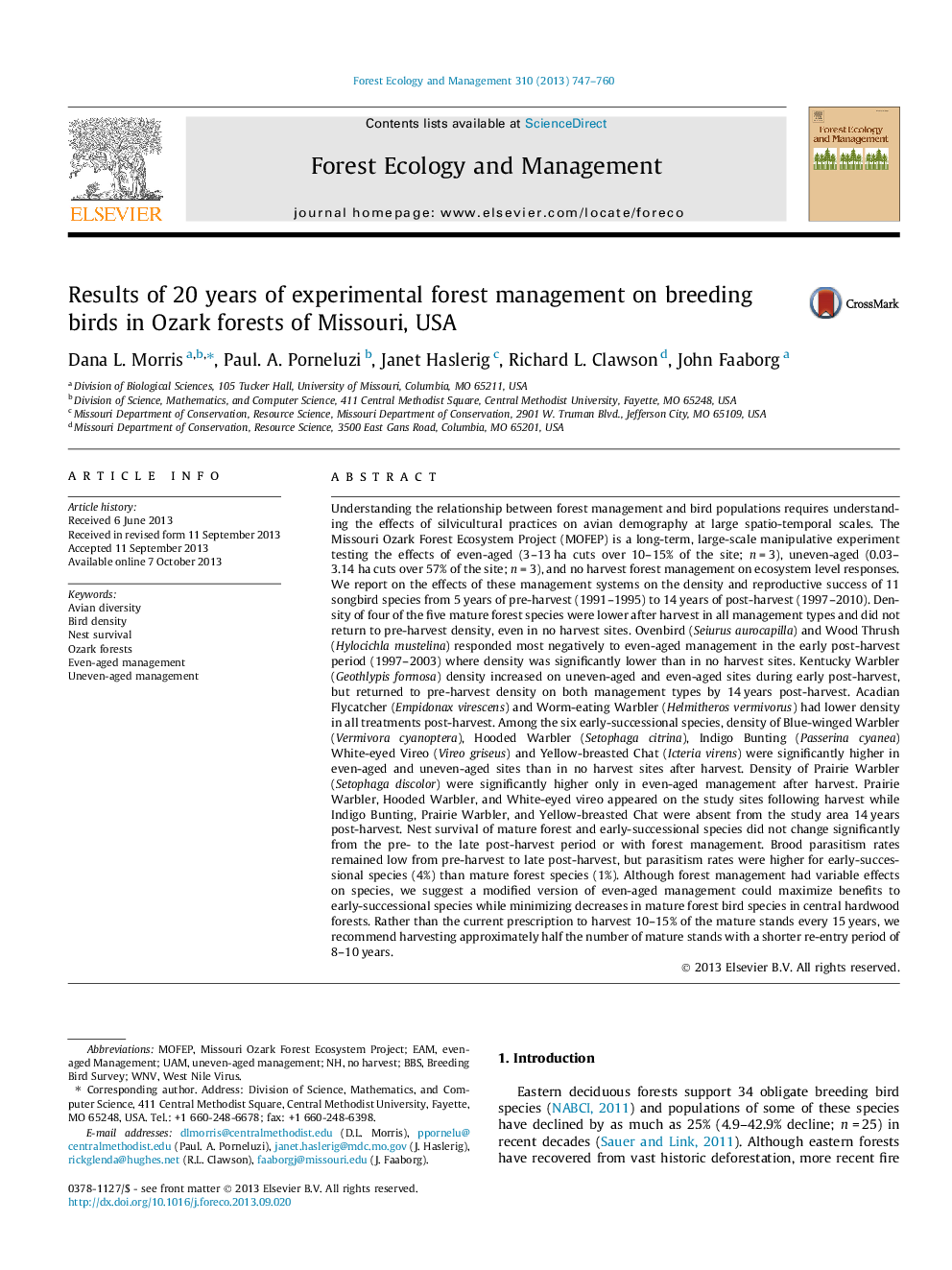| کد مقاله | کد نشریه | سال انتشار | مقاله انگلیسی | نسخه تمام متن |
|---|---|---|---|---|
| 6543855 | 159212 | 2013 | 14 صفحه PDF | دانلود رایگان |
عنوان انگلیسی مقاله ISI
Results of 20 years of experimental forest management on breeding birds in Ozark forests of Missouri, USA
دانلود مقاله + سفارش ترجمه
دانلود مقاله ISI انگلیسی
رایگان برای ایرانیان
کلمات کلیدی
موضوعات مرتبط
علوم زیستی و بیوفناوری
علوم کشاورزی و بیولوژیک
بوم شناسی، تکامل، رفتار و سامانه شناسی
پیش نمایش صفحه اول مقاله

چکیده انگلیسی
Understanding the relationship between forest management and bird populations requires understanding the effects of silvicultural practices on avian demography at large spatio-temporal scales. The Missouri Ozark Forest Ecosystem Project (MOFEP) is a long-term, large-scale manipulative experiment testing the effects of even-aged (3-13 ha cuts over 10-15% of the site; n = 3), uneven-aged (0.03-3.14 ha cuts over 57% of the site; n = 3), and no harvest forest management on ecosystem level responses. We report on the effects of these management systems on the density and reproductive success of 11 songbird species from 5 years of pre-harvest (1991-1995) to 14 years of post-harvest (1997-2010). Density of four of the five mature forest species were lower after harvest in all management types and did not return to pre-harvest density, even in no harvest sites. Ovenbird (Seiurus aurocapilla) and Wood Thrush (Hylocichla mustelina) responded most negatively to even-aged management in the early post-harvest period (1997-2003) where density was significantly lower than in no harvest sites. Kentucky Warbler (Geothlypis formosa) density increased on uneven-aged and even-aged sites during early post-harvest, but returned to pre-harvest density on both management types by 14 years post-harvest. Acadian Flycatcher (Empidonax virescens) and Worm-eating Warbler (Helmitheros vermivorus) had lower density in all treatments post-harvest. Among the six early-successional species, density of Blue-winged Warbler (Vermivora cyanoptera), Hooded Warbler (Setophaga citrina), Indigo Bunting (Passerina cyanea) White-eyed Vireo (Vireo griseus) and Yellow-breasted Chat (Icteria virens) were significantly higher in even-aged and uneven-aged sites than in no harvest sites after harvest. Density of Prairie Warbler (Setophaga discolor) were significantly higher only in even-aged management after harvest. Prairie Warbler, Hooded Warbler, and White-eyed vireo appeared on the study sites following harvest while Indigo Bunting, Prairie Warbler, and Yellow-breasted Chat were absent from the study area 14 years post-harvest. Nest survival of mature forest and early-successional species did not change significantly from the pre- to the late post-harvest period or with forest management. Brood parasitism rates remained low from pre-harvest to late post-harvest, but parasitism rates were higher for early-successional species (4%) than mature forest species (1%). Although forest management had variable effects on species, we suggest a modified version of even-aged management could maximize benefits to early-successional species while minimizing decreases in mature forest bird species in central hardwood forests. Rather than the current prescription to harvest 10-15% of the mature stands every 15 years, we recommend harvesting approximately half the number of mature stands with a shorter re-entry period of 8-10 years.
ناشر
Database: Elsevier - ScienceDirect (ساینس دایرکت)
Journal: Forest Ecology and Management - Volume 310, 15 December 2013, Pages 747-760
Journal: Forest Ecology and Management - Volume 310, 15 December 2013, Pages 747-760
نویسندگان
Dana L. Morris, Paul. A. Porneluzi, Janet Haslerig, Richard L. Clawson, John Faaborg,